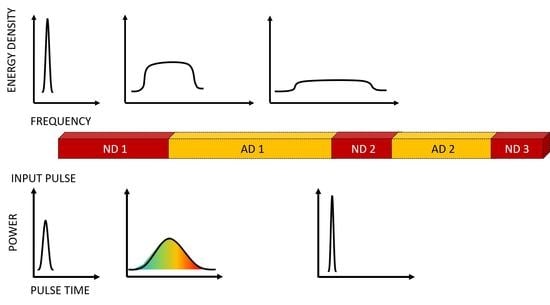Enhanced Pulse Compression within Sign-Alternating Dispersion Waveguides
Abstract
1. Introduction
2. Concept of Alternating Dispersion Waveguides and Methods
2.1. Concept of Alternating Dispersion Waveguides
2.2. Methods
3. Results
3.1. Convergence to Near Parabolic Spectral Phase in the SPM-Dominated Regime
3.1.1. SPM Effects on Second-Order Spectral Phase
3.1.2. SPM Effects on Third-Order and Higher Spectral Phase
3.1.3. SPM Leads to a Parabolic Spectral Phase Convergence
3.1.4. Impact of SPM Induced Phase Coefficient Reduction in the Design and Context of Alternating Dispersion Waveguides
3.2. AD GVD in the Dispersion-Dominated Regime
3.3. Sign-Alternating Dispersion in Integrated Photonics
4. Discussion
- The minimal compressed duration is the duration of the fundamental soliton allowed with a given pulse energy because spectral generation terminates once a soliton is formed, and the fundamental soliton is the shortest allowed.
- The final pulse duration may not reach the lower limit duration described in 1., since formation of a higher-order soliton, at a narrower bandwidth stops nonlinear compression to the fundamental. The higher-order soliton forms first because its generation length is shorter by a factor of the soliton number than that of the fundamental soliton [1,40].
5. Conclusions
Supplementary Materials
Funding
Institutional Review Board Statement
Informed Consent Statement
Data Availability Statement
Acknowledgments
Conflicts of Interest
References
- Dudley, J.M.; Genty, G.; Coen, S. Supercontinuum generation in photonic crystal fiber. Rev. Mod. Phys. 2006, 78, 1135–1184. [Google Scholar] [CrossRef]
- Heidt, A.M.; Feehan, J.S.; Price, J.H.V.; Feurer, T. Limits of coherent supercontinuum generation in normal dispersion fibers. J. Opt. Soc. Am. B 2017, 34, 764–775. [Google Scholar] [CrossRef]
- Manzoni, C.; Mücke, O.D.; Cirmi, G.; Fang, S.; Moses, J.; Huang, S.-W.; Hong, K.-H.; Cerullo, G.; Kärtner, F.X. Coherent pulse synthesis: Towards sub-cycle optical waveforms. Laser Photonics Rev. 2015, 9, 129–171. [Google Scholar] [CrossRef]
- Hassan, M.T.; Luu, T.T.; Moulet, A.; Raskazovskaya, O.; Zhokhov, P.; Garg, M.; Karpowicz, N.; Zheltikov, A.M.; Pervak, V.; Krausz, F.; et al. Optical attosecond pulses and tracking the nonlinear response of bound electrons. Nature 2016, 530, 66–70. [Google Scholar] [CrossRef] [PubMed]
- Hemmer, M.; Baudisch, M.; Thai, A.; Couairon, A.; Biegert, J. Self-compression to sub-3-cycle duration of mid-infrared optical pulses in dielectrics. Opt. Express 2013, 21, 28095–28102. [Google Scholar] [CrossRef]
- Chen, H.-W.; Zia, H.; Lim, J.K.; Xu, S.; Yang, Z.; Kärtner, F.X.; Chang, G. 3 GHz, Yb-fiber laser-based, few-cycle ultrafast source at the Ti: Sapphire laser wavelength. Opt. Lett. 2013, 38, 4927–4930. [Google Scholar] [CrossRef]
- Yu, M.; Okawachi, Y.; Griffith, A.G.; Picqué, N.; Lipson, M.; Gaeta, A.L. Silicon-chip-based mid-infrared dual-comb spectroscopy. Nat. Commun. 2018, 9, 1–6. [Google Scholar] [CrossRef]
- Luke, K.; Okawachi, Y.; Lamont, M.R.E.; Gaeta, A.L.; Lipson, M. Broadband mid-infrared frequency comb generation in a Si3N4 microresonator. Opt. Lett. 2015, 40, 4823. [Google Scholar] [CrossRef]
- Schliesser, A.; Picqué, N.; Hänsch, T.W. Mid-infrared frequency combs. Nat. Photonics 2012, 6, 40–449. [Google Scholar] [CrossRef]
- Rieker, G.B.; Giorgetta, F.R.; Swann, W.C.; Kofler, J.; Zolot, A.M.; Sinclair, L.C.; Baumann, E.; Cromer, C.; Petron, G.; Sweeney, C.; et al. Frequency-comb-based remote sensing of greenhouse gases over kilometer air paths. Optica 2014, 1, 290. [Google Scholar] [CrossRef]
- Holzwarth, R. Optical frequency metrology. Nat. Rev. 2002, 416, 1–5. [Google Scholar]
- Humbert, G.; Wadsworth, W.J.; Leon-Saval, S.G.; Knight, J.C.; Birks, T.A.; Russell, P.S.J.; Lederer, M.J.; Kopf, D.; Wiesauer, K.; Breuer, E.I.; et al. Supercontinuum generation system for optical coherence tomography based on tapered photonic crystal fibre. Opt. Express 2006, 14, 1596. [Google Scholar] [CrossRef]
- Unterhuber, A.; Považay, B.; Bizheva, K.; Hermann, B.; Sattmann, H.; Stingl, A.; Le, T.; Seefeld, M.; Menzel, R.; Preusser, M. Advances in broad bandwidth light sources for ultrahigh resolution optical coherence tomography. Phys. Med. Biol. 2004, 49, 1235–1246. [Google Scholar] [CrossRef]
- Israelsen, N.M.; Petersen, C.R.; Barh, A.; Jain, D.; Jensen, M.; Hannesschlaeger, G.; Tidemand-Lichtenberg, P.; Pedersen, C.; Podoleanu, A.; Bang, O.L. Real-time high-resolution mid-infrared optical coherence tomography. Light Sci. Appl. 2019, 8, 1–13. [Google Scholar] [CrossRef]
- Du, Q.; Luo, Z.; Zhong, H.; Zhang, Y.; Huang, Y.; Du, T.; Zhang, W.; Gu, T.; Hu, J. Chip-scale broadband spectroscopic chemical sensing using an integrated supercontinuum source in a chalcogenide glass waveguide. Photonics Res. 2018, 6, 506–510. [Google Scholar] [CrossRef]
- Kaminski, C.F.; Watt, R.S.; Elder, A.D.; Frank, J.H.; Hult, J. Supercontinuum radiation for applications in chemical sensing and microscopy. Appl. Phys. B 2008, 92, 367–378. [Google Scholar] [CrossRef]
- Zia, H.; Lüpken, N.M.; Hellwig, T.; Fallnich, C.; Boller, K.-J. Supercontinuum Generation in Media with Sign-Alternated Dispersion. Laser Photonics Rev. 2020, 6, 2000031. [Google Scholar] [CrossRef]
- Carlson, D.R.; Hutchison, P.; Hickstein, D.D.; Papp, S.B. Generating few-cycle pulses with integrated nonlinear photonics. Opt. Express 2019, 27, 37374–37382. [Google Scholar] [CrossRef] [PubMed]
- Foster, M.A.; Gaeta, A.L.; Cao, Q.; Trebino, R. Soliton-effect compression of supercontinuum to few-cycle durations in photonic nanowires. Opt. Express 2005, 13, 6848–6855. [Google Scholar] [CrossRef] [PubMed]
- Singh, N.; Vermulen, D.; Ruocco, A.; Li, N.; Ippen, E.; Kärtner, F.X.; Watts, M.R. Supercontinuum generation in varying dispersion and birefringent silicon waveguide. Opt. Express 2019, 27, 31698–31712. [Google Scholar] [CrossRef]
- Ciret, C.; Gorza, S.P. Generation of ultra-broadband coherent supercontinua in tapered and dispersion-managed silicon nanophotonic waveguides. JOSA B 2017, 34, 1156–1162. [Google Scholar] [CrossRef]
- Hu, H.; Zhang, X.; Li, W.; Dutta, N.K. Simulation of octave spanning mid-infrared supercontinuum generation in dispersion-varying planar waveguides. Appl. Opt. 2015, 54, 3448–3454. [Google Scholar] [CrossRef]
- Travers, J.C.; Popov, S.V.; Taylor, J.R. Extended blue supercontinuum generation in cascaded holey fibers. Opt. Lett. 2005, 30, 3132–3134. [Google Scholar] [CrossRef]
- Alfano, R.R. The Supercontinuum Laser Source: The Ultimate White Light; Springer: New York, NY, USA, 2016. [Google Scholar]
- Zeytunyan, A.; Yesayan, G.; Mouradian, L.; Kockaert, P.; Emplit, P.; Louradour, F.; Barthélémy, A. Nonlinear-dispersive similariton of passive fiber. J. Eur. Opt. Soc. Rapid Publ. 2009, 4. [Google Scholar] [CrossRef]
- Finot, C.; Millot, G.; Dudley, J.M. Asymptotic characteristics of parabolic similariton pulses in optical fiber amplifiers. Opt. Lett. 2004, 29, 2533–2535. [Google Scholar] [CrossRef]
- Finot, C.; Parmigiani, F.; Petropoulos, P.; Richardson, D.J. Parabolic pulse evolution in normally dispersive fiber amplifiers preceding the similariton formation regime. Opt. Express 2006, 14, 3161–3170. [Google Scholar] [CrossRef] [PubMed]
- Finot, C. Dispersion managed self-similar parabolic pulses. J. Opt. 2008, 10, 085101. [Google Scholar] [CrossRef][Green Version]
- Hori, T.; Takayanagi, J.; Nishizawa, N.; Goto, T. Flatly broadened, wideband and low noise supercontinuum generation in highly nonlinear hybrid fiber. Opt. Express 2004, 12, 317–324. [Google Scholar] [CrossRef]
- Heidt, A.M.; Rothhardt, J.; Hartung, A.; Bartelt, H.; Rohwer, E.G.; Limpert, J.; Tünnermann, A. High quality sub-two cycle pulses from compression of supercontinuum generated in all-normal dispersion photonic crystal fiber. Opt. Express 2011, 19, 13873–13879. [Google Scholar] [CrossRef]
- Demmler, S.; Rothhardt, J.; Heidt, A.M.; Hartung, A.; Rohwer, E.G.; Bartelt, H.; Limpert, J.; Tünnermann, A. Generation of high quality, 1.3 cycle pulses by active phase control of an octave spanning supercontinuum. Opt. Express 2011, 19, 20151–20158. [Google Scholar] [CrossRef]
- Sukhoivanov, I.A.; Iakushev, S.O.; Shulika, O.V.; Andrade-Lucio, J.A.; Díez, A.; Andrés, M. Supercontinuum generation at 800 nm in all-normal dispersion photonic crystal fiber. Opt. Express 2014, 22, 30234–30250. [Google Scholar] [CrossRef]
- Xing, S.; Kharitonov, S.; Hu, J.; Brès, C.S. Linearly chirped mid-infrared supercontinuum in all-normal-dispersion chalcogenide photonic crystal fibers. Opt. Express 2018, 26, 19627–19636. [Google Scholar] [CrossRef] [PubMed]
- Malomed, B.A. Soliton Management in Periodic Systems; Springer: New York, NY, USA, 2006. [Google Scholar]
- Essiambre, R.J.; Raybon, G.; Mikkelsen, B. Optical Fiber Telecommunications IV B; Academic Press: New York, NY, USA, 2002; pp. 253–275. [Google Scholar]
- Zitelli, M.; Matera, F.; Settembre, M. 40-Gbit/s transmission in dispersion managed links with step-index fiber and linear compensation. Opt. Lett. 1999, 24, 1169–1171. [Google Scholar] [CrossRef] [PubMed]
- Hult, J. A fourth-order Runge–Kutta in the interaction picture method for simulating supercontinuum generation in optical fibers. J. Light. Technol. 2007, 25, 3770–3775. [Google Scholar] [CrossRef]
- Paschotta, R. Field Guide to Optical Fiber Technology; SPIE: Bellingham, WA, USA, 2010. [Google Scholar]
- Dong, X.; Yang, Q.; Spiess, C.; Bucklew, V.G.; Renninger, W.H. Stretched-pulse soliton Kerr resonators. Phys. Rev. Lett. 2020, 125, 033902. [Google Scholar] [CrossRef]
- Yang, Q.; Spiess, C.; Bucklew, V.G.; Renninger, W.H. Stretched-Pulse Solitons in Driven Fiber Resonators. In Proceedings of the CLEO: Science and Innovations, San Jose, CA, USA, 5–10 May 2019; Optical Society of America: Washington, DC, USA, 2019; p. SF1L-3. [Google Scholar]
- Lüpken, N.M.; Fallnich, C. Bandwidth-limited few-cycle pulses by nonlinear compression in a dispersion-alternating fiber. Appl. Phys. B 2020, 126, 1–7. [Google Scholar] [CrossRef]
- Travers, J.C.; Grigorova, T.F.; Brahms, C.; Belli, F. High-energy pulse self-compression and ultraviolet generation through soliton dynamics in hollow capillary fibres. Nat. Photonics 2019, 13, 547–554. [Google Scholar] [CrossRef]
- Zia, H. Enhanced Nonlinear Pulse Compression Sign-Alternating Dispersion Waveguides at Low Input Peak Powers. In Proceedings of the Mid-Infrared Coherent Sources, Washington, DC, USA, 16–20 November 2020; Optical Society of America: Washington, DC, USA, 2020; p. MM1C-4. [Google Scholar]

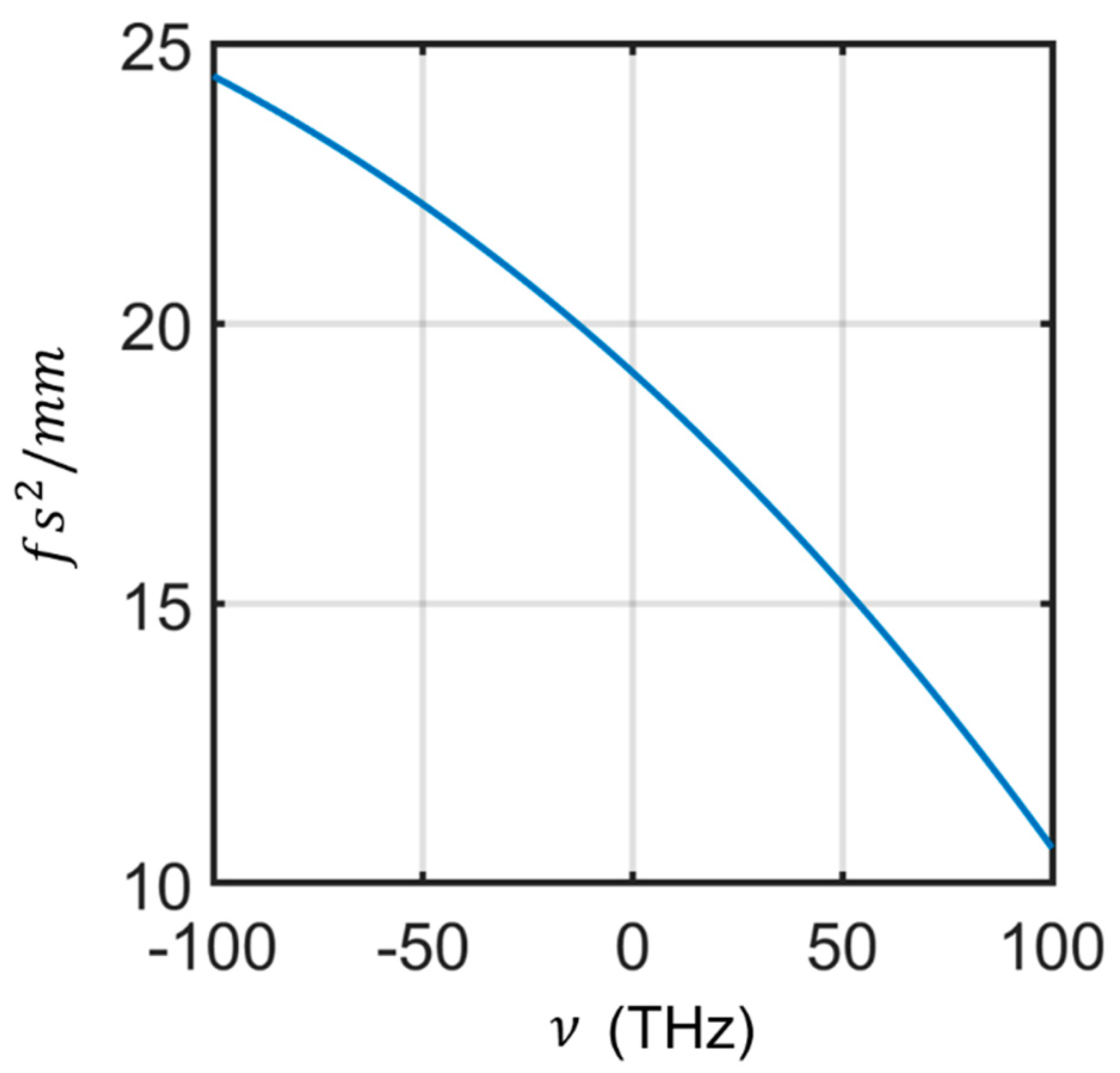
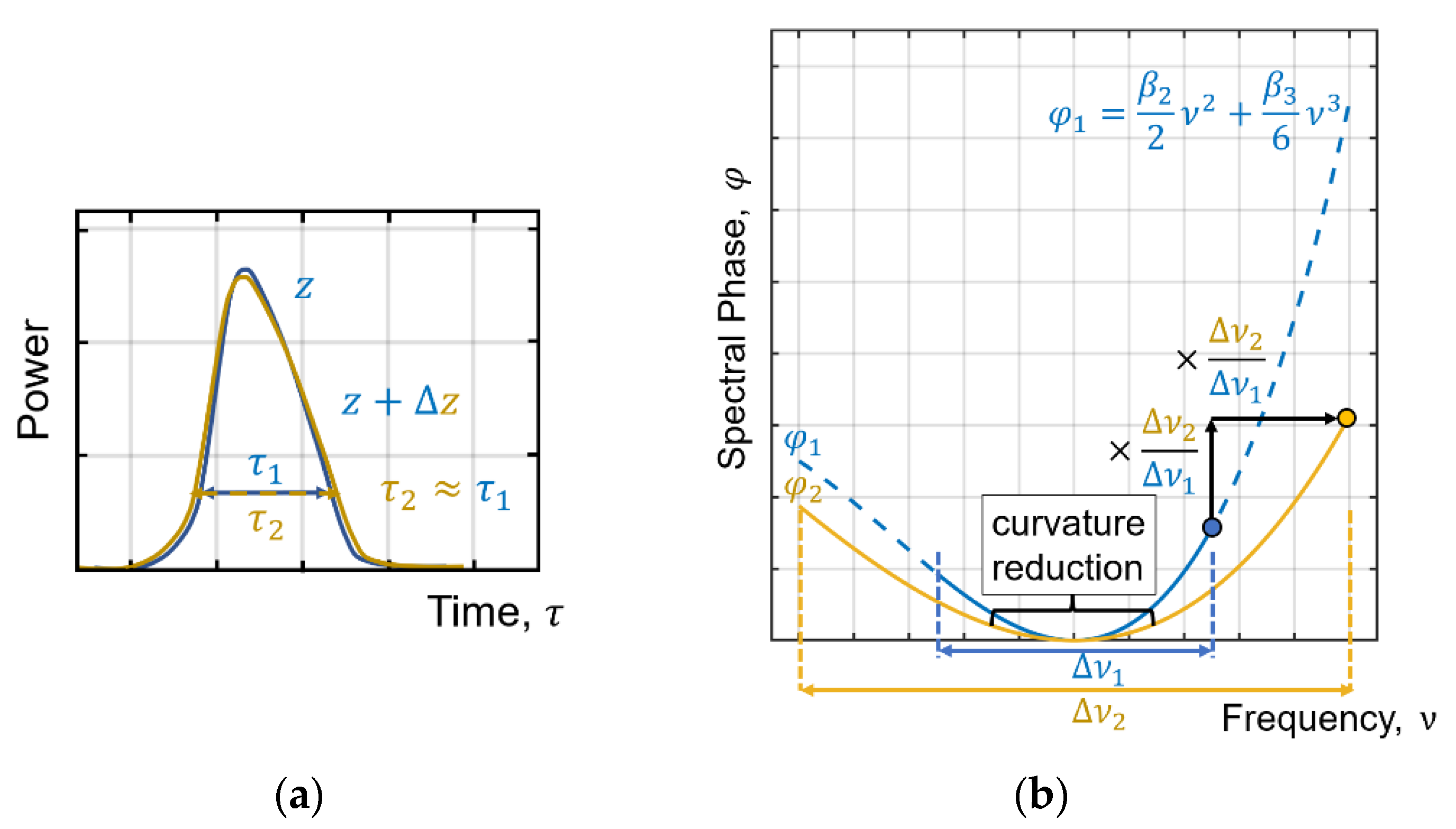

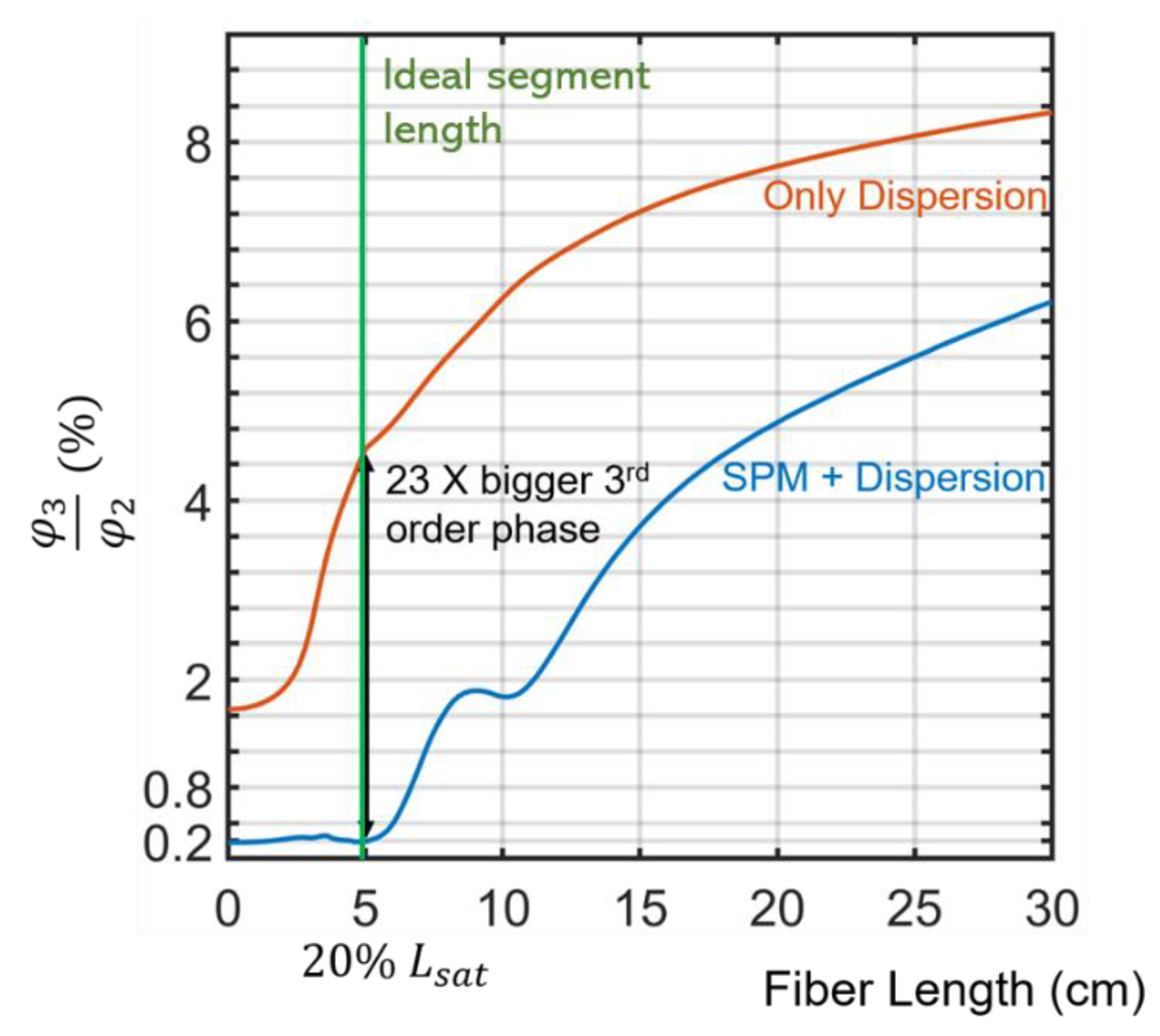
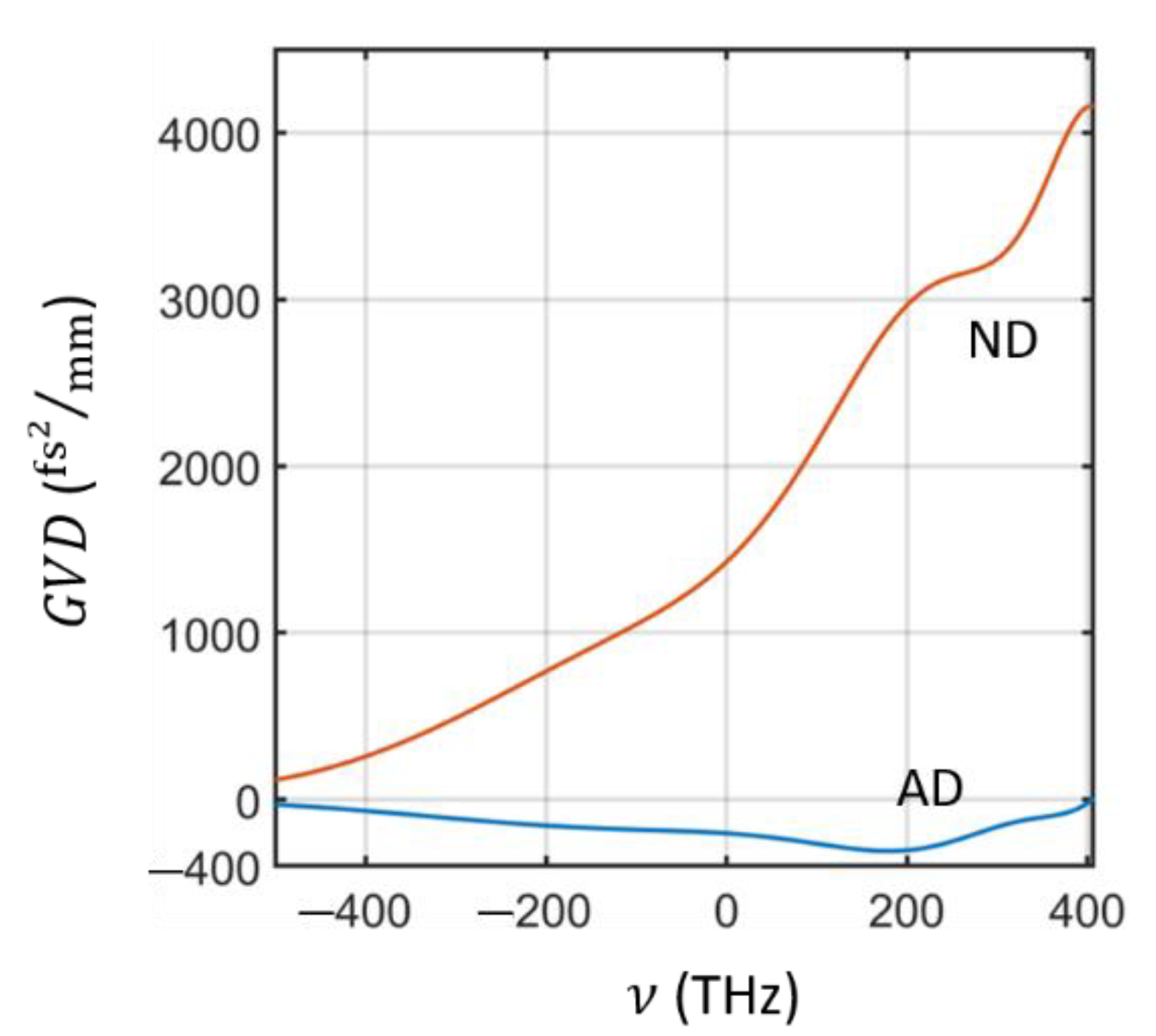
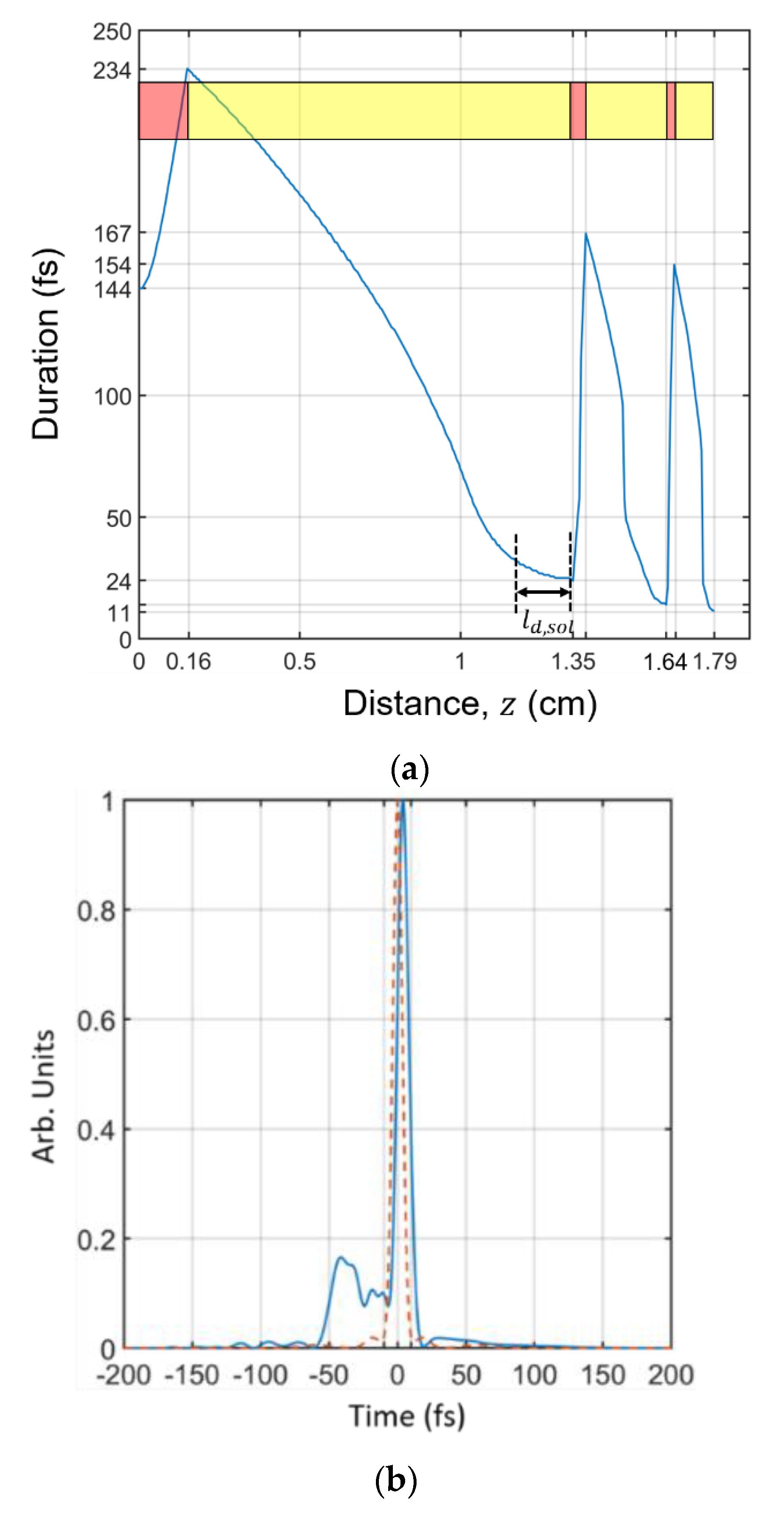

Publisher’s Note: MDPI stays neutral with regard to jurisdictional claims in published maps and institutional affiliations. |
© 2021 by the author. Licensee MDPI, Basel, Switzerland. This article is an open access article distributed under the terms and conditions of the Creative Commons Attribution (CC BY) license (http://creativecommons.org/licenses/by/4.0/).
Share and Cite
Zia, H. Enhanced Pulse Compression within Sign-Alternating Dispersion Waveguides. Photonics 2021, 8, 50. https://doi.org/10.3390/photonics8020050
Zia H. Enhanced Pulse Compression within Sign-Alternating Dispersion Waveguides. Photonics. 2021; 8(2):50. https://doi.org/10.3390/photonics8020050
Chicago/Turabian StyleZia, Haider. 2021. "Enhanced Pulse Compression within Sign-Alternating Dispersion Waveguides" Photonics 8, no. 2: 50. https://doi.org/10.3390/photonics8020050
APA StyleZia, H. (2021). Enhanced Pulse Compression within Sign-Alternating Dispersion Waveguides. Photonics, 8(2), 50. https://doi.org/10.3390/photonics8020050




